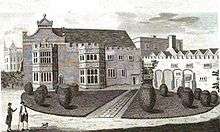Hinchingbrooke House
Hinchingbrooke House in Huntingdon, Cambridgeshire, was built around an 11th-century Benedictine nunnery. After the Reformation it passed into the hands of the Cromwell family, and subsequently, became the home of the Earls of Sandwich, including John Montagu, 4th Earl of Sandwich, reputedly the "inventor" of the modern sandwich.


On 8 March 1538, Richard Williams (alias Cromwell) had the grant of the nunnery of Hinchinbrooke, in Huntingdonshire, for the undervalued price of £19. 9s. 2d. while he was an official Visitor overseeing the dissolution of the monasteries.[1] His son, Henry Williams (alias Cromwell)—a grandfather of Oliver Cromwell—built the house adjoining to the nunnery,[2] and upon the bow windows he put the arms of his family, with those of several others to whom he was allied.[3]
There was a serious fire in 1830 and the house was restored/rebuilt by Edward Blore; it was further restored in 1894 and again in the 1960s. During the most recent restoration the entrance to the chapter house was discovered, but otherwise little of the medieval fabric is visible.[4]
In 1970, it became part of Hinchingbrooke School,[5] housing the 6th form. Hinchingbrooke School was formerly Huntingdon Grammar School which, on the site of what is now the Cromwell Museum in Huntingdon, was attended by Oliver Cromwell and Samuel Pepys.[6][7] The school now has around 1900 pupils.[8]
More recently, while still being used as a school, Hinchingbrooke House is turned into a critically acclaimed scare attraction in the Halloween season called 'The Horror at Hinchingbrooke House'. It is also used as a conference centre, and is also for, dinner dances and as a wedding venue. It is a Grade I listed building and is open for tours on Sunday afternoons in the summer season.[9][10][11]
Notes
- Noble 1784, p. 7 cites: Grant in the possession of the Earl of Sandwich.
- "The nuns apartments, or cells, at Hinchinbrook, are now entire, and are used as lodging-rooms for the menial servants; their common room was what is now the kitchen; the church is destroyed, except some trifling remains, now part of one of the walls of the house, and seem to have been the corner of the tower; near this place in lowering the flooring, a few years ago, one or more coffins of stone were found." (Noble 1784, p. 21 writing in 1787)
- Noble 1784, p. 22, Cites: Vide the engravings of the arms at Hinchinbrook.
- "Listed Buildings and Conservation Areas". Historic England. 1951. Retrieved 27 June 2016.
- HH staff
- Goldsmith 1999.
- Grey 2004, The History of Hinchingbrooke House.
- Grey 2004, The Headmasters & The School
- HH staff
- Grey 2004, Hinchingbrooke House.
- Historic England. "Hinchingbrooke House (1128649)". National Heritage List for England. Retrieved 10 July 2015.
References
- Goldsmith, John, ed. (1999). "exhibitions>Cromwell>Where did he come from?". Cambridgeshire Education, Libraries and Heritage.CS1 maint: ref=harv (link)
- Grey, Duncan, ed. (2004). "Hinchingbrooke House". The History of Hinchingbrooke House (website). Retrieved November 2011. Check date values in:
|accessdate=(help); External link in|publisher=(help)CS1 maint: ref=harv (link) - HH staff. "About Hinchingbrooke House". Hinchingbrooke House and Performing Arts Centre. Archived from the original on 9 January 2012. Retrieved 4 November 2010. External link in
|publisher=(help)CS1 maint: ref=harv (link) - Noble, Mark (1784). Memoirs of the Protectorate-house of Cromwell: Deduced from an Early Period, and Continued Down to the Present Time,... 2. Printed Pearson and Rollason.CS1 maint: ref=harv (link)
- Attribution
